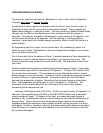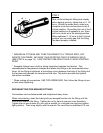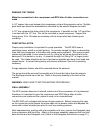
10
INSTALLATION
Installer's care should be stressed. No matter how good SEA FROST equipment is, its
performance and life are in the hands of the installer. To insure your work:
1. Read this manual.
2. Reread any aspect you don't understand.
3. Follow Swagelok fitting instructions carefully.
4. Spend enough time leak-checking to be sure there are no leaks.
5. Thanks from all of us who have to guarantee your work.
There are two contaminants that will give you problems in any refrigeration system.
They are WATER and DIRT. Moisture is always present and cannot be eliminated,
water in this case refers to puddles and drops. Dirt is any solid. The installer's habits
will be most important in ensuring a trouble-free start-up. We have added a large
receiver filter dryer (RFD) to take care of all dirt and moisture that might get into the
system during a careful installation. Moisture in the system is boiled off when the
system is evacuated, or it is captured in the desiccant. There is a screen in the
expansion valve to prevent dirt from plugging it.
Excess moisture that the RFD can't handle will plug the expansion valve with ice. This
ice stops the cycle. The only cure is to discharge the refrigerant, replace the RFD, re-
evacuate the system, and recharge it. This remedy takes time and is somewhat costly.
Keep the system clean when installing it to save time for something more fun.
TUBE HANDLING
Installation is quite simple. All the copper tube comes to you with the ends capped.
Any routing of the tube must be done with the tube either taped or capped. Cap both
tube ends after each cut. (Spare caps have been included). Work with only one line at
a time, and only uncap one end at a time.
TUBE CUTTING
Use only a tube cutter; hacksawing or any other method will introduce chips to the
system and also distort the tube, making connections difficult and leak-prone. A
miniature cutter is essential for this work. CUT SLOWLY to avoid a ridge on the inside
of the tube. We do not recommend reaming or dressing the cut, as it is very easy to get
chips of copper in the system, which may cause trouble.
TUBE BENDING
Make all but the long sweep bends with a spring bender; one kink and the line must be
rerun. Don't add any more fittings than are absolutely necessary. Route all lines in
such a way that they are most direct but out of the way. Again, keep everything sealed
until you are ready to make that connection.


















